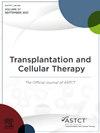同种异体造血干细胞移植后肺活量降低≥10%的患者死亡率增加:一项来自单一移植服务的5年回顾性随访研究。
IF 3.6
3区 医学
Q2 HEMATOLOGY
引用次数: 0
摘要
背景:肺移植物抗宿主疾病是造血干细胞移植(HSCT)常见的严重并发症。在肺功能发生不可逆转的变化之前,早期诊断对于快速治疗至关重要。美国国立卫生研究院(NIH)支持造血干细胞移植后,如果一秒钟用力呼气容积(FEV1)比基线值下降≥10%,就需要进一步检查和密切监测。以往的研究表明,移植后 6 个月内 FEV1 下降 10%-19% 和≥20% 与 1 次死亡的几率较高有关;但据作者所知,目前还没有关于 6 个月后出现 FEV1 下降的长期随访数据:我们旨在研究通过肺活量测定法测量的 FEV1 下降≥10% 对预测造血干细胞移植受者 5 年内全因死亡率的临床意义。研究还将符合美国国立卫生研究院(NIH)肺坏死诊断标准的患者进行了比较:研究设计:对在韦斯特米德接受异基因造血干细胞移植的患者的长期随访数据进行了回顾性审核,普查期为5年。肺功能下降的定义是 FEV1 与最佳值相比变化≥10%,通常是在移植过程开始时。肺功能恢复是指与患者肺功能最大下降值相比,FEV1增加≥10%。当符合以下标准时,即可诊断为肺功能缺损:FEV1/FVC比值小于0.7,FEV1结果:对2013年至2019年期间接受异基因造血干细胞移植的364名患者的数据进行了分析;173名患者(47.7%)在移植后FEV1下降≥10%。95名患者的FEV1下降持续了1次,持续时间超过6个月,并且不太可能恢复任何丧失的肺功能(FEV恢复百分比中位数=0%)。FEV1下降≥10%与死亡之间存在明显关系,X2(1,364)= 15.67,P 1次下降(34%),而未出现任何下降者(16%)。出现下降但未恢复的患者死亡率最高(OR = 2.98 [1.64-5.41])。然而,与 FEV1 下降≥10% 的患者相比,FEV1 下降后又恢复的患者死亡率仍然较高(OR = 2.08 [1.17-3.69]):结论:从 FEV1 首次下降≥10% 开始,死亡率风险就会升高,即使 FEV1 恢复,死亡率风险仍会升高。FEV1 下降超过 6 个月的患者,尽管经过治疗,FEV1 也不太可能恢复。如果 FEV1 比移植前的值下降至少≥10%,则应立即进行快速评估,以识别和治疗死亡风险,并尽量减少整体呼吸功能的下降。本文章由计算机程序翻译,如有差异,请以英文原文为准。
Mortality Is Increased in Those with a ≥10% Reduction in Spirometry Following Allogeneic Hematopoietic Stem Cell Transplant: A Retrospective 5-Year Follow-up Study from a Single Transplant Service
Pulmonary graft versus host disease (GVHD) is a common and serious complication of hematopoietic stem cell transplantation (HSCT). Early diagnosis is essential for rapid treatment before irreversible changes in lung function occur. The National Institutes of Health (NIH) support that a decline in forced expiratory volume in 1 second (FEV1) of ≥10% from baseline values requires further investigation and close monitoring post HSCT. Previous research demonstrates that a 10% to 19% and ≥20% reduction in FEV1 within 6 months of transplantation is associated with higher odds of 1-year mortality. However, to the authors’ knowledge, there is no long-term follow-up data of FEV1 decline with an onset after the first 6-month period. We aimed to investigate the clinical significance of a ≥10% decrement in FEV1 measured by spirometry for predicting all-cause mortality in HSCT recipients over a period of 5 years. A comparison was made with patients who met the NIH diagnostic criteria for lung GVHD. Long-term follow-up data of patients who received an allogeneic HSCT at Westmead was audited retrospectively using a censoring period of 5 years. A decrease in lung function was defined as a change in FEV1 by ≥10% from their best value, usually at the beginning of the transplant process. Recovery was defined as a ≥10% increase in FEV1 from the patient’s maximum decline in lung function. A diagnosis of lung GVHD was made when the following criteria were met: FEV1/forced vital capacity (FVC) ratio of <0.7, and an FEV1 <75% of predicted normal with ≥10% reduction over less than 2 years and evidence of gas trapping. Data from 364 patients who underwent an allogeneic HSCT between 2013 and 2019 were analyzed; 173 patients (47.7%) experienced a ≥10% reduction in FEV1 after transplantation. Ninety-five patients experienced an FEV1 decline lasting <6 months and were likely to recover over half their lost lung function (median % FEV recovered = 68.7%). Seventy-eight patients experienced an FEV1 decline lasting >6 months and were unlikely to recover any lost lung function (median % FEV recovered = 0%). There was a significant relationship between ≥10% FEV1 decline and death, X2(1, 364) = 15.67, P < .001. All-cause mortality was doubled in those who experienced ≥10% FEV1 decline (34%) compared with those without any decline (16%). Mortality was highest in those who experienced decline without any recovery (odds ratio [OR], 2.98; 95% confidence interval [CI], 1.64-5.41). However, in the group who had a decline and then later recovered, mortality was still elevated (OR, 2.08; 95 CI, 1.17-3.69) compared with those who did not experience any FEV1 decline ≥10%. Mortality risk is elevated from the first ≥10% reduction in FEV1 and remains elevated even if FEV1 recovery occurs. Individuals whose FEV1 declines for longer than 6 months are unlikely to experience FEV1 recovery despite treatment. An FEV1 decline of at least ≥10% from pretransplant value should trigger rapid assessment to identify and treat mortality risks and to minimize decline in overall respiratory function.
求助全文
通过发布文献求助,成功后即可免费获取论文全文。
去求助
来源期刊

Transplantation and Cellular Therapy
Medicine-Hematology
CiteScore
7.00
自引率
15.60%
发文量
1061
审稿时长
51 days
 求助内容:
求助内容: 应助结果提醒方式:
应助结果提醒方式:


